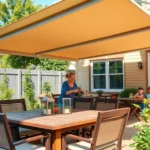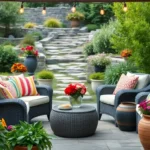We all know that feeling when you walk into your living room and something just doesn’t feel right. Maybe it’s the outdated furniture that’s seen better days or the color scheme that made sense five years ago but now feels completely off. Your living room is the heart of your home – it’s where we gather with family, entertain friends, and unwind after long days.
The good news? You don’t need a complete overhaul or a massive budget to transform your space into something spectacular. With the right remodel ideas, we can help you create a living room that perfectly reflects your style while maximizing both function and comfort.
Whether you’re working with a cozy apartment or a spacious family room, we’ve compiled proven strategies that’ll breathe new life into your space. From clever layout tricks to budget-friendly updates that deliver maximum impact, these ideas will guide you toward the living room you’ve always envisioned.
Planning Your Living Room Remodel for Maximum Impact
Strategic planning transforms your living room remodel from overwhelming to achievable. We’ll guide you through the essential steps that ensure your renovation delivers both visual appeal and practical functionality.
Setting a Realistic Budget and Timeline
Establishing your budget first prevents costly surprises down the road. Most homeowners spend between $2,500 to $15,000 on living room remodels, depending on scope and materials chosen. Allocate 20% of your total budget for unexpected expenses like electrical work or structural issues.
Breaking down costs by category helps you prioritize spending. Paint and accessories typically consume 15-25% of your budget, while furniture takes 40-60%. Flooring accounts for 20-30% if you’re making changes. Labor costs vary significantly by region but generally represent 30-40% of professional renovation expenses.
Timeline planning keeps your project on track and manageable. Simple cosmetic updates like painting and new accessories take 1-2 weeks. Furniture replacement and layout changes require 3-4 weeks for delivery and installation. Major renovations involving flooring or built-ins extend to 6-8 weeks.
Assessing Your Current Space and Layout
Measuring your room accurately forms the foundation of successful planning. Document ceiling height, wall dimensions, and window placement before making any design decisions. Note electrical outlet locations and lighting fixtures that might impact furniture arrangement.
Traffic flow analysis reveals how people naturally move through your space. Walk through your current layout and identify bottlenecks or awkward pathways. Mark high-traffic areas where durable materials and open spaces become priorities.
Natural light assessment influences color choices and furniture placement. Observe how sunlight enters throughout the day and note any dark corners that need additional illumination. South-facing rooms handle bold colors better while north-facing spaces benefit from warm, light hues.
Existing architectural features either enhance or constrain your design options. Built-in shelving, fireplaces, and structural columns create focal points worth highlighting. Awkward angles or low ceilings require creative answers like strategic lighting or visual tricks.
Defining Your Style and Functional Needs
Identifying your design style prevents costly mistakes and ensures cohesive results. Browse magazines and online galleries to collect images that resonate with you. Modern farmhouse, minimalist, and transitional styles remain popular for their versatility and timeless appeal.
Functional requirements guide every design decision you’ll make. List activities your living room must accommodate: entertaining guests, family movie nights, reading, or working from home. Each function influences seating arrangements, storage needs, and lighting requirements.
Lifestyle considerations shape practical design choices throughout your space. Families with young children prioritize durable fabrics and rounded furniture edges. Pet owners select materials that resist scratching and hair accumulation. Empty nesters might emphasize comfort and sophisticated entertaining features.
Creating a mood board solidifies your vision before purchases begin. Combine fabric swatches, paint samples, and furniture photos to visualize how elements work together. Digital tools like Pinterest or physical boards help you spot potential conflicts early in the planning process.
Optimizing Your Living Room Layout and Flow
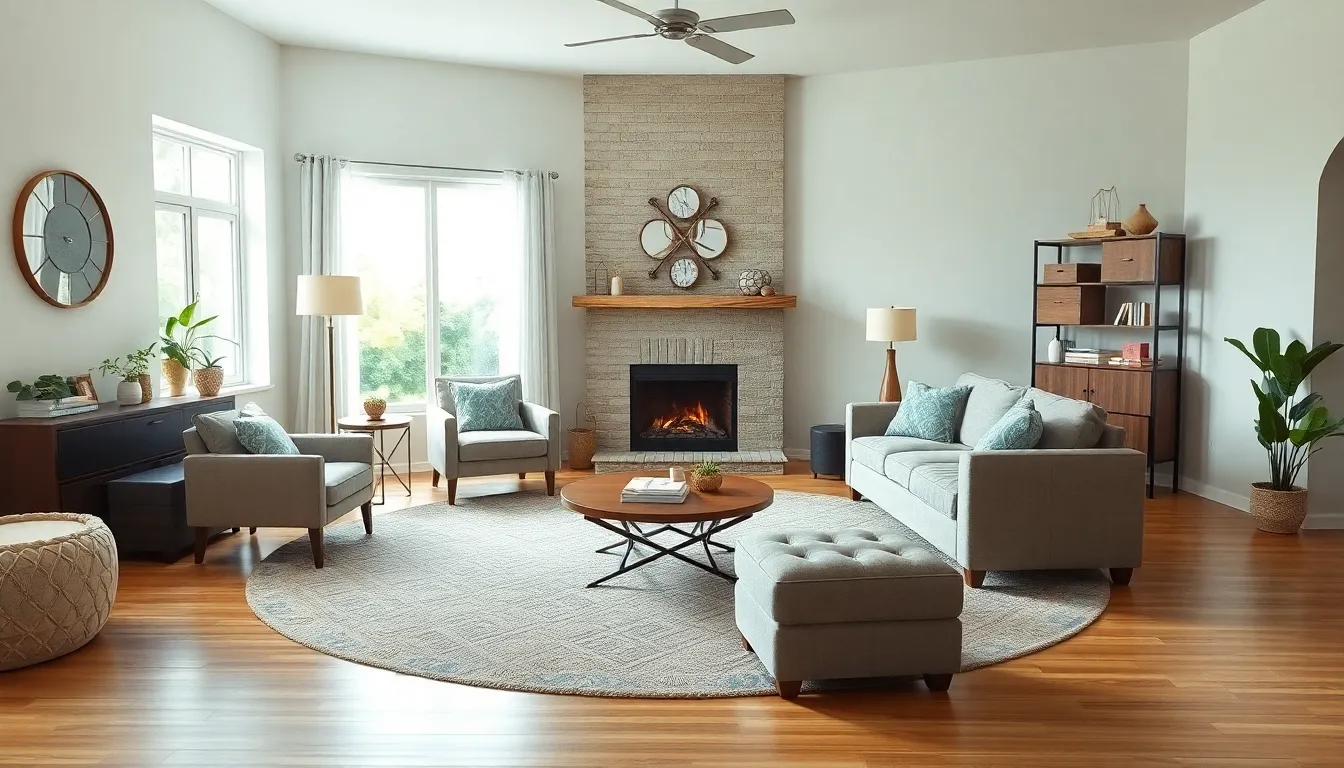
Smart layout planning transforms any living room into a space that works beautifully for daily life. We’ll show you how to create zones that enhance both functionality and visual appeal.
Creating Conversation-Friendly Seating Arrangements
Positioning furniture to encourage interaction makes your living room the heart of your home. We recommend arranging seating in a circular configuration to help easy conversation among family and guests. Face chairs and sofas toward each other rather than pushing everything against the walls to create an intimate, welcoming atmosphere.
Your main seating area should center around a focal point like a fireplace, large window, or entertainment center. This approach guides the natural flow of conversation while giving the room visual purpose. Consider floating furniture pieces away from walls to create multiple conversation zones in larger spaces.
Maximizing Traffic Flow and Movement
Clear pathways prevent your living room from feeling cramped and ensure easy movement throughout the space. We suggest maintaining at least 3 feet of walking space between major furniture pieces to allow comfortable passage. Avoid packing too much furniture into the room, as overcrowding creates congestion and makes the space feel smaller.
Incorporate angled or curved furniture pieces to create natural movement patterns and direct traffic flow smoothly around seating areas. Position larger items like bookcases and entertainment centers along walls to keep central areas open. Strategic placement of side tables and ottomans can guide movement without blocking pathways.
Incorporating Multi-Functional Furniture Answers
Multi-purpose pieces maximize your living room’s potential while reducing visual clutter. We recommend choosing storage ottomans that serve as extra seating, footrests, and hidden storage for blankets or games. Coffee tables with built-in drawers or shelving provide surface space while keeping remote controls and magazines organized.
Wall-mounted shelves and floating desks use vertical space effectively, keeping floor areas clear for better traffic flow. Consider console tables that double as desk space or dining surfaces in smaller homes. Nesting tables offer flexible surface options that tuck away when not needed, adapting to your changing daily needs.
Selecting the Perfect Color Palette for Your Space

Now that we’ve optimized our layout and flow, we’ll focus on creating a color palette that truly transforms our living room. Color selection forms the foundation of any successful remodel and sets the entire mood for our space.
Choosing Paint Colors That Transform Your Room
Bold and moody colors dominate 2025 interior design trends, with professionals moving away from traditional light neutrals toward deeper, richer shades. Emerald greens, navy blues, and warm browns create dramatic focal points that add personality and depth to our living rooms.
Natural light levels in our space determine which colors work best. Rooms with abundant sunlight can handle saturated tones that create intimacy and highlight architectural features. Spaces with limited natural light benefit from warm neutrals or soft pastels that maintain openness and prevent the room from feeling cramped.
Textured wall finishes elevate our color choices beyond simple paint. Grasscloth wallpaper adds organic texture while geometric wall panels introduce visual interest through pattern and shadow play. These options create color variation that changes throughout the day as light shifts across the surfaces.
Accent walls offer a compromise between bold and neutral approaches. We can paint one wall in a rich hue while keeping the remaining walls neutral, creating a striking focal point without overwhelming the entire space. This technique works particularly well behind seating areas or entertainment centers.
Incorporating Accent Colors Through Accessories
Throw pillows serve as our most flexible color introduction tool. We can swap them seasonally or whenever we want to refresh our palette without major expense. Mixing different textures and patterns in complementary colors creates visual depth while maintaining cohesion.
Area rugs anchor our color scheme and define separate zones within the living room. A boldly patterned rug can introduce multiple accent colors that we can echo throughout the space in smaller accessories. Solid colored rugs in vibrant hues provide a strong foundation for neutral furniture.
Artwork and wall decor distribute color at eye level throughout the room. We can select pieces that feature our chosen accent colors or introduce entirely new hues that complement our base palette. Gallery walls allow us to experiment with multiple colors while maintaining visual unity through consistent framing or spacing.
Plants and natural elements bring organic color variations into our space. Different shades of green from various plant species create a living color palette that changes with seasons and growth patterns.
Balancing Neutral Tones with Bold Statement Pieces
Neutral wall colors create the perfect backdrop for colorful furniture pieces. When we use beige, gray, or white walls, our bright sofa or patterned chairs become the room’s focal points. This approach allows us to change our color scheme through furniture rather than repainting.
Statement furniture pieces require careful positioning to maximize their impact. We should place our boldest colored furniture where it naturally draws attention, such as opposite the main entrance or facing our primary seating area. This positioning creates visual hierarchy and guides guests’ eyes through the space.
Layered textures enhance our neutral and bold color combinations. Plush fabrics on neutral furniture paired with smooth surfaces on colorful pieces create tactile contrast that makes our color choices more captivating. Organic materials like wood and stone add warmth to both neutral and bold elements.
The 60-30-10 rule helps us distribute colors effectively throughout our living room. We should use neutral tones for 60% of the space, a secondary color for 30%, and bold accent colors for the remaining 10%. This proportion ensures our room feels balanced rather than chaotic or overwhelming.
Upgrading Your Flooring for Style and Durability
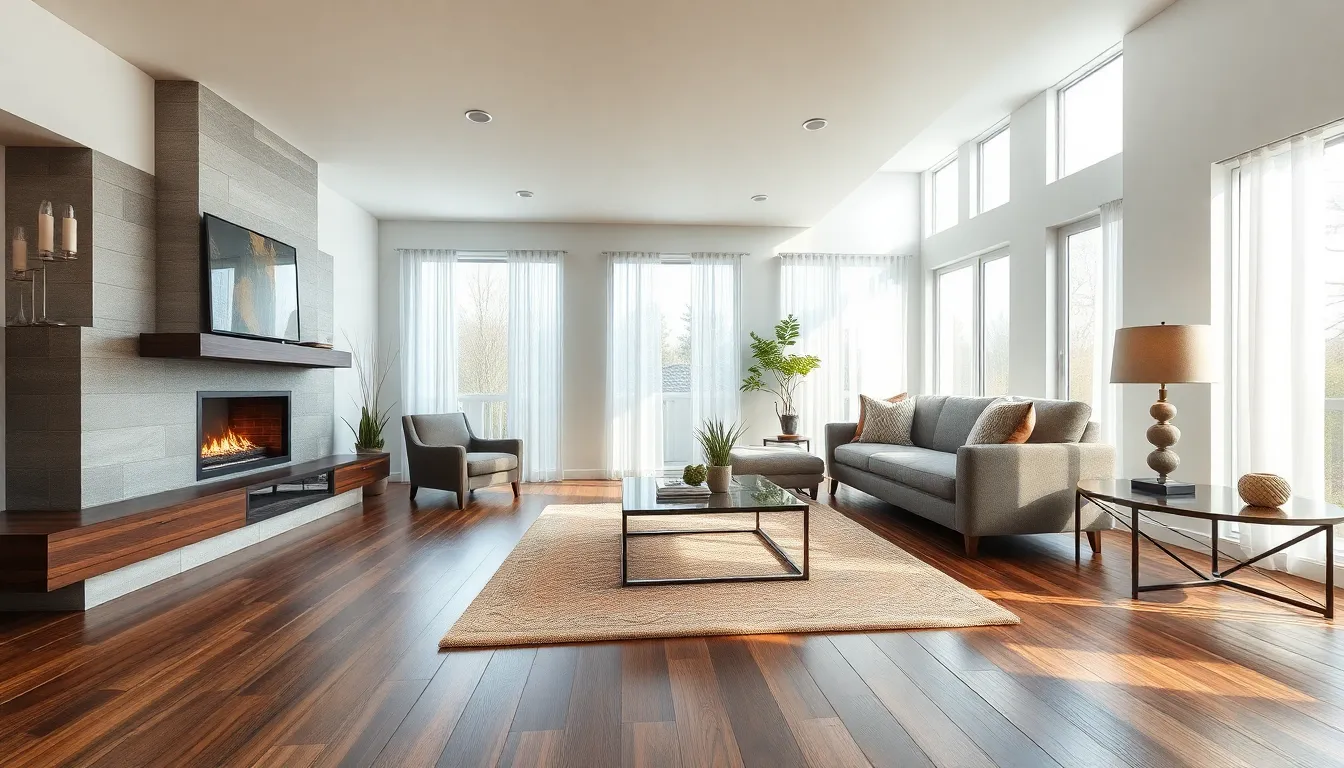
Flooring choices can dramatically transform your living room’s aesthetic while providing the durability needed for high-traffic areas. We’ll explore the most popular options that combine style with practicality for your remodel.
Exploring Hardwood, Laminate, and Luxury Vinyl Options
Hardwood flooring remains the gold standard for living room remodels due to its timeless appeal and exceptional durability. This classic option adds warmth and sophistication to any space while maintaining its value over time. Installation costs range higher than alternatives, but the long-term investment proves worthwhile for most homeowners.
Laminate flooring offers a cost-effective alternative that mimics hardwood’s appearance without the premium price tag. Modern laminate options provide surprisingly realistic wood textures and patterns that fool even close inspection. Installation becomes significantly easier compared to traditional hardwood, making it an attractive DIY-friendly option for budget-conscious remodelers.
Luxury Vinyl Tile (LVT) delivers versatility that adapts to various design preferences while offering superior moisture resistance. This innovative flooring can replicate wood, stone, or ceramic appearances with remarkable accuracy. LVT’s durability makes it ideal for living rooms that experience heavy foot traffic, pets, or children’s activities.
Adding Warmth with Area Rugs and Carpeting
Area rugs introduce texture and visual interest while defining distinct zones within larger living spaces. Strategic rug placement can anchor seating arrangements and create intimate conversation areas that feel more welcoming. Layering different textures through rugs adds depth to your flooring design without permanent commitment.
Wall-to-wall carpeting provides ultimate comfort underfoot while offering sound absorption benefits for multi-story homes. Modern carpet options include stain-resistant treatments and low-maintenance fibers that handle family life demands. Neutral carpet colors create a foundation that accommodates changing decor trends and furniture arrangements.
Combining hard surfaces with soft textiles creates balance that appeals to both visual and tactile senses. This approach allows you to enjoy the durability of hard flooring while incorporating cozy elements that make the space feel lived-in and comfortable.
Considering Tile and Stone for Modern Appeal
Ceramic and porcelain tiles deliver contemporary sophistication with unmatched durability and easy maintenance requirements. Large-format tiles create seamless appearances that make rooms feel more spacious and modern. These materials resist stains, scratches, and moisture better than most other flooring options.
Natural stone options like marble and granite bring luxury elements that serve as stunning focal points in living room designs. Stone flooring offers unique patterns and textures that can’t be replicated by manufactured materials. Professional installation ensures proper sealing and longevity for these premium materials.
Maintenance considerations for tile and stone include regular sealing for natural materials and grout cleaning for all tiled surfaces. But, daily care remains minimal compared to carpet or hardwood requirements. These surfaces work exceptionally well with radiant heating systems for added comfort during colder months.
Enhancing Your Lighting Design Strategy
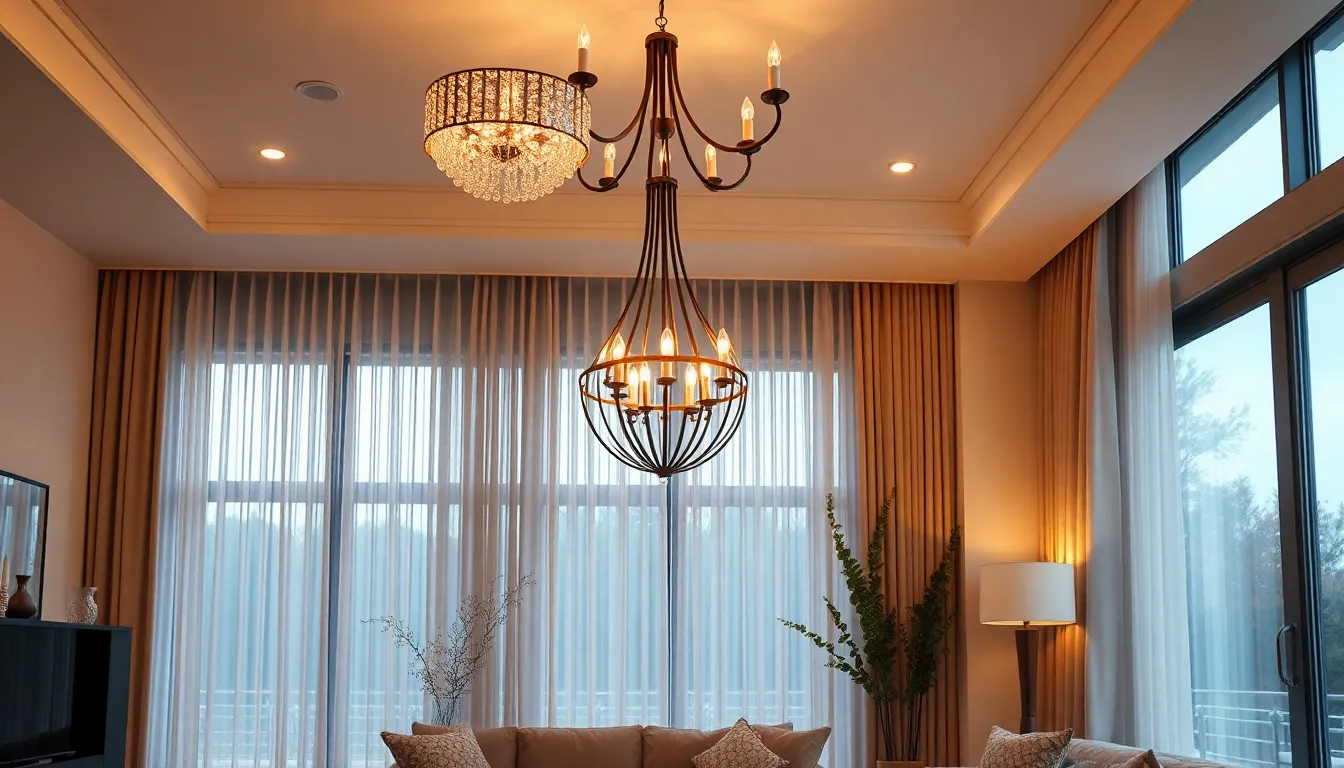
Lighting transforms our living room’s atmosphere more dramatically than any other single design element. We’ll explore how layered lighting creates depth and functionality while establishing the perfect mood for every occasion.
Installing Statement Chandeliers and Pendant Lights
Statement chandeliers serve as stunning focal points that elevate our living room’s sophistication instantly. We recommend choosing fixtures that complement our existing decor style while adding visual interest to the ceiling plane. Modern chandeliers with clean lines work beautifully in contemporary spaces, while crystal or brass options enhance traditional room designs.
Pendant lights offer versatile lighting answers that work especially well in open concept living areas. We can install multiple pendants at varying heights to create visual rhythm and guide the eye through different zones. Consider oversized pendant fixtures above seating areas to define conversation spaces while providing adequate illumination for evening gatherings.
Sizing matters significantly when selecting statement lighting fixtures for our living room. We should measure our room’s dimensions carefully, ensuring chandeliers are proportionate to the space. A general rule suggests choosing fixtures that are 12 inches narrower than our room’s width to achieve proper visual balance.
Incorporating Task and Ambient Lighting Answers
Task lighting addresses exact activities we perform in our living room daily. We need strategically placed table lamps near reading chairs, floor lamps beside sofas, and under cabinet lighting for display areas. These focused light sources eliminate harsh shadows while supporting activities like reading, crafting, or working on laptops.
Ambient lighting provides the foundational illumination that fills our entire living space. We can achieve this through recessed ceiling lights, wall sconces, or floor lamps with upward facing bulbs. Dimmer switches allow us to adjust ambient lighting levels throughout the day, creating cozy evening atmospheres or bright daytime environments.
Layering different lighting types creates the most functional and appealing living room environment. We recommend combining at least three lighting sources in each room: ambient for general illumination, task for exact activities, and accent for highlighting artwork or architectural features. This approach ensures our space feels welcoming while meeting all our practical lighting needs.
Maximizing Natural Light with Window Treatments
Sheer curtains allow sunlight to filter through while maintaining privacy throughout the day. We can hang these lightweight fabrics alone or layer them with heavier drapes for maximum flexibility. White or cream colored sheers reflect natural light deeper into our living room, making spaces appear larger and more inviting.
Blinds provide precise control over the amount of natural light entering our living space. We prefer adjustable slat blinds that can direct sunlight upward toward the ceiling, bouncing light throughout the room without creating glare on screens or artwork. Horizontal blinds work well for standard windows, while vertical options suit sliding glass doors.
Shades offer clean lines and efficient light management for modern living room designs. We can choose from cellular shades that insulate while filtering light, or roller shades that disappear completely when raised. Roman shades add textural interest while providing similar light control benefits to traditional curtains.
Window placement and treatment selection significantly impact our living room’s natural light distribution. We should avoid heavy, dark colored window coverings that block precious daylight during peak hours. Instead, we recommend light colored fabrics and strategic layering that allows us to maximize natural illumination while controlling privacy and glare as needed.
Transforming Your Walls with Creative Design Elements

Walls serve as the backdrop for everything else in our living rooms, making them prime candidates for impactful design changes. Strategic wall transformations can dramatically alter the feel of our space without requiring major construction work.
Adding Texture with Wallpaper and Wall Panels
Textured wallpaper introduces visual depth that paint alone can’t achieve. Grasscloth wallpaper brings natural organic textures into our living spaces while geometric patterns create contemporary sophistication. We recommend selecting wallpaper with intricate patterns that complement existing furniture rather than competing with it.
Three-dimensional wall panels offer another avenue for adding substantial texture to our walls. These panels create dramatic shadow play throughout the day as natural light shifts across their surfaces. Custom wood panels work particularly well behind entertainment centers while decorative plaster panels suit more traditional design schemes.
Installation considerations matter significantly when choosing between wallpaper and panels. Wallpaper typically costs between $30-100 per roll and covers approximately 60 square feet. Wall panels range from $15-50 per square foot depending on materials and complexity.
Creating Focal Points with Accent Walls
Bold accent walls draw attention to exact areas while defining different zones within open floor plans. We suggest choosing walls that naturally command attention, such as those behind sofas or fireplaces. Deep emerald greens and navy blues work exceptionally well for creating moody focal points that don’t overwhelm the space.
Material diversity elevates accent walls beyond simple paint applications. Stone veneer creates rustic charm while metal panels introduce industrial elements. Reclaimed wood planks offer warmth and texture that complements both modern and farmhouse aesthetics.
Strategic placement ensures accent walls enhance rather than fragment our living spaces. We recommend limiting accent treatments to one wall per room to maintain visual balance. Consider traffic patterns and viewing angles when selecting which wall receives the accent treatment.
Incorporating Built-in Storage and Shelving
Custom built-in storage maximizes every inch of available wall space while maintaining clean lines throughout our living rooms. Floor-to-ceiling units create impressive vertical storage that keeps clutter completely hidden from view. We can integrate these systems around existing architectural features like windows and doorways for seamless appearance.
Floating shelves provide display opportunities without the visual weight of traditional bookcases. These shelves work particularly well for showcasing decorative objects, books, and plants while maintaining an open feel. Strategic spacing between shelves creates visual rhythm along our walls.
Innovative storage answers include rotating bookcases that serve dual purposes as room dividers and storage units. Built-in window seats with hidden storage combine seating with organization while maximizing natural light areas. Corner units make use of often-wasted space while adding architectural interest to our rooms.
Choosing Furniture That Combines Style and Comfort

Modern living room furniture in 2025 seamlessly blends aesthetic appeal with practical comfort, creating spaces that work beautifully for both daily relaxation and entertaining guests. We’re seeing a shift toward modular pieces and sculptural forms that prioritize both visual impact and long-term usability.
Selecting the Right Sofa and Seating Options
Sectional sofas remain the cornerstone of versatile living room design, offering flexible arrangements that adapt to various room sizes and social configurations. Modular seating systems allow us to reconfigure our space as needs change, whether we’re hosting a movie night or intimate conversation.
Curved and rounded sofa shapes dominate current trends, replacing sharp angles with softer silhouettes that create more inviting atmospheres. These organic forms work particularly well in open floor plans where furniture needs to complement flowing traffic patterns.
Upholstered pieces featuring plush fabrics like velvet and bouclé provide the tactile comfort we crave while adding visual texture to our spaces. Ergonomic considerations ensure these statement pieces support our bodies during extended lounging sessions, with supportive cushions and proper back alignment.
Armchairs serve as accent pieces that introduce color and personality while providing additional seating for guests. Ottomans and accent chairs create layered seating arrangements that encourage social interaction and provide flexible options for different activities.
Incorporating Coffee Tables and Side Tables
Coffee tables function as both practical surfaces and sculptural centerpieces in today’s living rooms, with organic shapes and mixed materials leading design preferences. Marble, wood, and glass combinations create visual interest while maintaining utility for everyday use.
Nesting tables offer adaptable answers that expand when we need extra surface space and tuck away when we want to maximize floor area. These multifunctional pieces work especially well in smaller living rooms where flexibility matters most.
Side tables positioned strategically near seating areas provide convenient spots for drinks, books, and personal items while contributing to the room’s overall design scheme. Materials like natural wood and stone bring warmth and texture that complement our furniture selections.
Sculptural table designs serve as conversation starters while maintaining their practical function, proving that utility doesn’t require sacrificing style. These pieces often feature unique bases or interesting proportions that add artistic elements to our living spaces.
Adding Storage Answers That Double as Decor
Integrated shelving systems blend seamlessly with our room’s architecture while providing essential storage for books, media, and decorative objects. Custom cabinetry maintains cohesive aesthetics by matching existing trim work and color schemes.
Multi-purpose credenzas hide clutter behind closed doors while offering display surfaces for curated collections like ceramics, plants, or family photos. These pieces work particularly well beneath wall-mounted televisions or as room dividers in open layouts.
Decorative baskets woven from natural materials provide flexible storage options that complement biophilic design trends while keeping everyday items organized. Wood finishes and natural textures integrate seamlessly with organic furniture shapes and materials.
Open shelving creates opportunities to showcase our personality through carefully arranged books, artwork, and plants while maintaining easy access to frequently used items. Built-in window seats combine storage functionality with additional seating, maximizing space efficiency in smaller rooms.
Textured wall finishes and strategic wallpaper placement help distinguish storage zones from seating areas while adding visual depth that makes storage answers feel intentional rather than utilitarian.
Personalizing Your Space with Decorative Accents
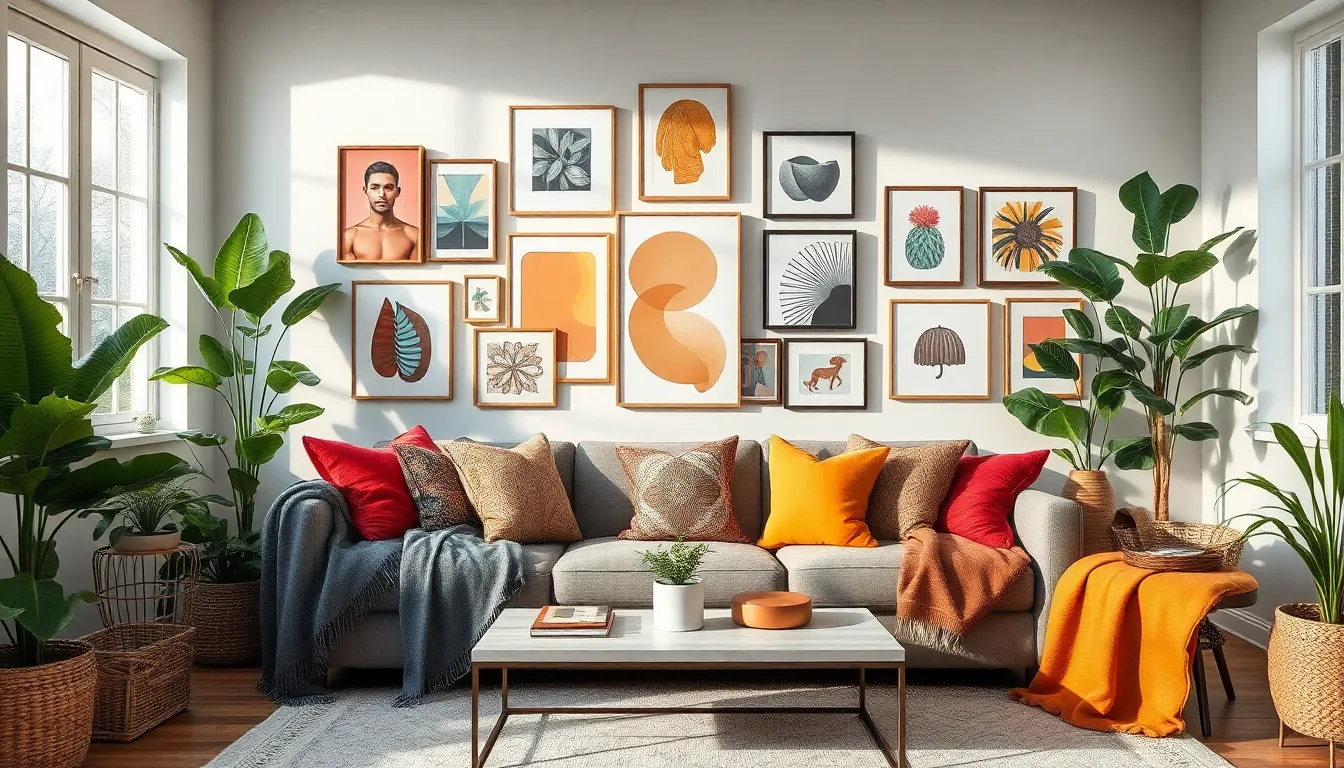
We believe that decorative accents transform a living room from a simple seating area into a reflection of your unique personality and style. These carefully chosen elements create the finishing touches that make your space feel truly yours.
Displaying Artwork and Photography Collections
Gallery walls serve as stunning focal points that showcase your personal taste and memories. Creating a cohesive display involves mixing different frame styles and sizes to achieve visual balance and interest. We recommend starting with your largest piece as an anchor, then building around it with smaller artworks and photographs.
Curating your collection becomes easier when you consider the room’s color palette and existing decor elements. Professional designers suggest maintaining consistent spacing between frames, typically 2-3 inches apart, to create a polished appearance. Your artwork should hang at eye level, with the center of each piece positioned 57-60 inches from the floor.
Photography collections work beautifully when grouped by theme, color, or subject matter. Black and white photographs create timeless elegance, while colorful prints can tie together various design elements throughout the room. Consider creating seasonal rotations to keep your display fresh and captivating year round.
Incorporating Plants and Natural Elements
Biophilic design principles emphasize the connection between indoor spaces and nature, improving both well being and sustainability in your living room. Plants naturally purify the air while adding vibrant color and organic textures that soften hard surfaces and architectural lines.
Strategic placement of greenery creates visual interest at different heights throughout the room. Floor plants like fiddle leaf figs or snake plants make bold statements in corners, while smaller potted plants work perfectly on coffee tables and shelving units. We suggest choosing plants that thrive in your room’s exact light conditions to ensure long term success.
Natural materials complement living plants beautifully and reinforce the organic aesthetic. Wood coffee tables, stone accent pieces, and woven baskets introduce earthy textures that ground the space. Maximizing natural light through thoughtful window treatments allows both plants and natural materials to shine while creating an airy, open atmosphere.
Adding Throw Pillows, Blankets, and Textiles
Maximalism trends encourage bold colors and patterns through throw pillows and blankets that instantly refresh your living room’s appearance. These versatile accessories offer the most budget friendly way to experiment with new color schemes and seasonal updates without major investments.
Layering different textures creates depth and visual richness that makes seating areas more inviting. Velvet pillows add luxury, while linen throws provide casual comfort, and wool blankets introduce cozy warmth during cooler months. We recommend using odd numbers of pillows (typically 3 or 5) on sofas to create more ever-changing arrangements.
Color coordination becomes effortless when you select textiles that incorporate your room’s accent colors while introducing new complementary shades. Patterns should vary in scale to avoid overwhelming the space, mixing large florals with small geometrics or stripes. Quality fabrics ensure your decorative textiles maintain their appearance through regular use and washing cycles.
Integrating Technology and Entertainment Systems
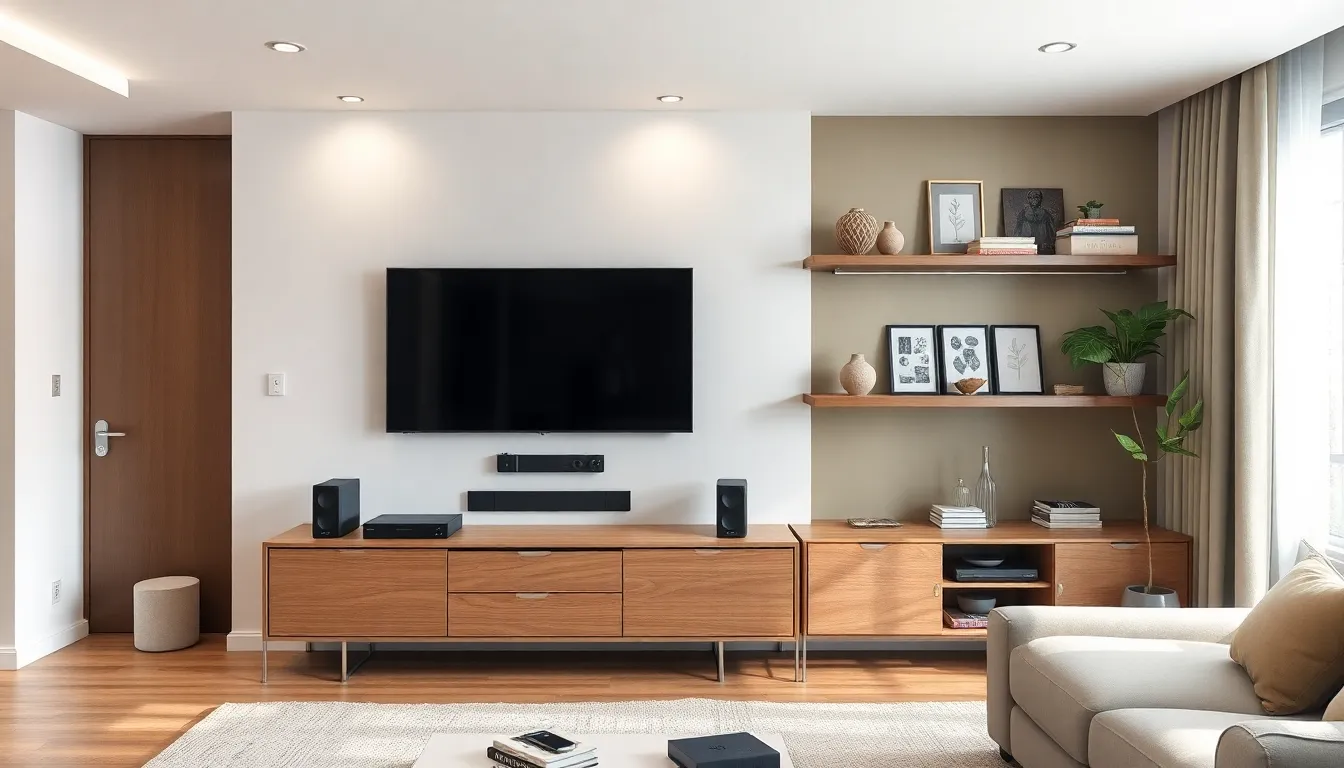
Modern living room design demands seamless technology integration that enhances functionality without compromising style. Smart entertainment systems like Sonos or Apple HomePod create immersive audio experiences while connecting multiple speakers for surround sound capabilities.
Mounting TVs and Organizing Media Equipment
Wall mounting your television creates a sleek, modern appearance while maximizing floor space in your living room. Professional installation ensures proper support and optimal viewing angles that prevent neck strain during extended watching sessions.
Modern media consoles serve dual purposes by organizing equipment and concealing unsightly cables from view. Select furniture pieces with built-in cable management systems that route wires through designated channels and compartments.
Entertainment centers with closed storage keep gaming consoles, streaming devices, and sound systems organized yet easily accessible. Choose designs that complement your room’s aesthetic while providing adequate ventilation for electronic components.
Floating shelves positioned strategically around your mounted TV create attractive displays for decorative items while housing additional media equipment. This approach maintains clean lines while adding functional storage to your entertainment area.
Incorporating Smart Home Features
Smart lighting systems offer customizable environments through features like dimming, color changing, and scheduling capabilities. Install smart bulbs throughout your living room to create different moods for various activities and times of day.
Voice controlled assistants such as Amazon Alexa, Google Assistant, or Apple HomePod provide hands-free control over your smart devices. These systems integrate seamlessly with entertainment equipment, lighting, and climate control for ultimate convenience.
WiFi thermostats learn your temperature preferences and adjust automatically for optimal energy efficiency throughout the day. Smart climate control reduces utility costs while maintaining comfortable living conditions without manual intervention.
Automated window treatments respond to voice commands or smartphone apps, allowing precise control over natural light levels. Motorized blinds and curtains enhance privacy while contributing to your home’s smart network integration.
Hiding Cables and Creating Clean Lines
Cable organizers eliminate visual clutter by routing wires through specialized channels and conduits behind furniture pieces. Invest in quality cable management answers that accommodate current equipment while allowing for future technology additions.
Built-in cable management systems integrated into furniture design provide invisible wire routing from source to destination. Media consoles with internal wire management keep connections organized while maintaining accessibility for maintenance and upgrades.
Invisible technology integration involves concealing speakers within walls, routing wiring through architectural elements, and embedding smart devices directly into room structures. This approach creates seamless functionality without visible technology components disrupting your design aesthetic.
Wireless technology reduces cable requirements significantly while maintaining high quality performance standards. Bluetooth speakers, wireless charging stations, and streaming devices minimize physical connections while maximizing flexibility in room arrangements.
Working with Professionals vs. DIY Approaches

Deciding between professional services and DIY projects can make or break your living room remodel. We’ll help you determine which tasks require expert skills and which ones you can confidently handle yourself.
Knowing When to Hire Contractors and Designers
Structural changes require professional contractors who understand load-bearing walls and building codes. Moving walls, adding beams, or altering the room’s footprint needs specialized expertise to ensure safety and compliance. Electrical work should always involve licensed professionals, especially when installing new outlets, updating wiring, or adding ceiling fans and chandeliers.
Custom carpentry projects benefit from skilled craftsmen who can create built-in entertainment centers, window seats, or floating shelves. Professional designers excel at space planning and layout optimization, helping you maximize your room’s potential while maintaining proper traffic flow. Color scheme selection becomes easier with design professionals who understand how natural light affects paint choices throughout the day.
Complex installations like hardwood flooring, tile work, or custom millwork often require specialized tools and years of experience. Plumbing adjustments for wet bars or decorative water features need licensed plumbers to prevent costly water damage. Professional installation ensures that expensive materials like natural stone or high-end lighting fixtures are properly secured and functional.
Identifying Projects You Can Tackle Yourself
Painting walls and ceilings represents one of the most rewarding DIY projects for living room remodels. Fresh paint can transform your space dramatically while keeping costs low and giving you complete control over the timeline. Installing new trim or molding adds architectural interest without requiring advanced carpentry skills.
Window treatments like curtains, blinds, or shades can be easily updated with basic measuring and mounting skills. Decorative wall elements such as peel-and-stick wallpaper, wall decals, or gallery walls let you personalize your space without permanent changes. Simple lighting updates including lamp installation, pendant light swapping, or adding LED strip lighting under shelves enhance ambiance affordably.
Furniture arrangement and styling projects allow you to reimagine your space using existing pieces in new configurations. Accessory updates through throw pillows, area rugs, plants, and decorative objects can refresh your living room’s look immediately. Basic shelving installation using brackets and boards creates storage answers without major construction.
Budgeting for Professional Services
Labor costs for professional contractors typically range from $30 to $125 per hour depending on the complexity and specialization required. General contractors charge less than specialized tradespeople like electricians or custom cabinet makers who command premium rates. Design consultations often cost between $100 to $200 per hour, though many designers offer package deals for complete room makeovers.
Material costs vary significantly based on your choices, with professionals often securing better pricing through trade discounts. Budget allocation should include 20% extra funds for unexpected expenses like discovering outdated wiring or water damage behind walls. Prioritizing tasks helps you tackle the most impactful changes first while spreading costs across multiple months.
Getting multiple quotes allows you to compare pricing and understand what’s included in each estimate. Some contractors offer design-build services that streamline the process but may cost more upfront. Payment schedules typically require deposits before work begins, with progress payments tied to completion milestones rather than upfront full payment.
| Service Type | Cost Range | Best For |
|---|---|---|
| General Contractor | $30-$75/hour | Structural changes, flooring |
| Interior Designer | $100-$200/hour | Space planning, color selection |
| Electrician | $50-$125/hour | Lighting, outlet installation |
| Custom Carpenter | $40-$100/hour | Built-ins, trim work |
Conclusion
Your living room transformation doesn’t have to be overwhelming or expensive. We’ve shown you that strategic planning paired with smart design choices can create the space you’ve always wanted.
Remember that every great remodel starts with understanding your needs and setting realistic goals. Whether you’re working with bold color palettes or upgrading your flooring the key is making decisions that reflect your lifestyle.
The beauty of living room remodeling lies in the flexibility to mix DIY projects with professional expertise. You can tackle simple updates like painting and styling while leaving complex work to the pros.
Most importantly trust your instincts and have fun with the process. Your living room should tell your story and provide the comfort and functionality your family deserves for years to come.
Frequently Asked Questions
How much should I budget for a living room remodel?
Most homeowners spend between $2,500 to $15,000 on living room remodels. It’s recommended to allocate 20% of your budget for unexpected expenses and break down costs by category to prioritize spending effectively. The final amount depends on the scope of changes, materials chosen, and whether you hire professionals or do DIY projects.
What’s the best way to plan my living room layout?
Start by taking accurate measurements of your space and assessing traffic flow, natural light, and existing architectural features. Arrange seating in a circular configuration around a focal point to foster conversation. Maintain clear pathways, avoid overcrowding, and incorporate multi-functional furniture to maximize both functionality and visual appeal.
What color trends are popular for living rooms in 2025?
Bold, moody colors like emerald greens and navy blues are trending for 2025. Consider your natural light when choosing colors, and use the 60-30-10 rule for effective color distribution. Textured wall finishes and accent walls add depth, while accessories like throw pillows and area rugs help introduce accent colors throughout the space.
What are the best flooring options for living rooms?
Popular options include hardwood for timeless appeal, laminate as a budget-friendly wood alternative, and luxury vinyl tile for versatility and moisture resistance. Area rugs add warmth and help define spaces, while tile and stone flooring offer durability and easy maintenance for high-traffic areas.
How can I improve lighting in my living room?
Use layered lighting with a combination of ambient, task, and accent lighting sources. Consider statement chandeliers or pendant lights as focal points. Maximize natural light with sheer curtains, blinds, or shades that allow light control while maintaining privacy. Smart lighting systems offer convenient control and customization options.
When should I hire professionals vs. doing DIY?
Hire contractors for structural changes, electrical work, plumbing, and complex installations that require permits or specialized expertise. DIY tasks include painting, installing window treatments, rearranging furniture, and simple decorative updates. Always prioritize safety and code compliance when making this decision.
How do I choose the right furniture for my living room?
Focus on pieces that combine style and comfort. Sectional sofas and curved shapes are popular trends for 2025. Choose multifunctional coffee tables and side tables that serve practical and aesthetic purposes. Consider modular pieces and sculptural forms that can adapt to changing needs while maintaining visual appeal.
What’s the best way to incorporate technology into my living room?
Install wall-mounted TVs and modern media consoles to organize equipment while concealing cables. Smart home features like voice-controlled assistants and smart lighting enhance convenience. Use wireless technology options to reduce clutter and invest in proper cable management systems to maintain a clean, organized aesthetic.


